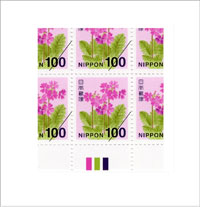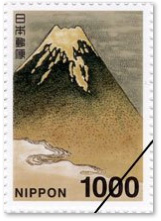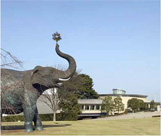February 2 issuance of a new series of definitive postage stamps produced using the National Printing Bureau’s gravure printing technique
update:2024/1/24
Beautifully colored and designed depictions of nature in Japan
On February 2, 2015, 12 newly designed definitive stamps with the theme of nature in Japan were issued. Along with the 11 new-denomination stamps launched on March 3, 2014, a total of 23 definitive stamps are now available. This represents the first major stamp design change since 1998.
The stamps are produced using the National Printing Bureau’s gravure printing method.
12 stamps (February 2, 2015 issuance)

11 stamps (March 3, 2014 issuance)

Note: Hisoka Maejima, who is seen as the father of the modern Japanese postal system for his work on its establishment, continues to appear on 1 yen stamps.

To commemorate the issuance of the new stamp series, a definitive stamp album including two special stamp sheets – one featuring a 2 yen mountain-hare stamp and a 3 yen chipmunk stamp, and the other featuring the old and new 1,000 yen stamps – was released by Japan Post. The album has been proven highly popular, and has already been sold out on Japan Post’s stamp shopping website.
Gravure printing using special color inks

Postage stamp color indicators(special colors)
The utilization of special colors in the printing process is essential for creating highly accurate reproductions of artistic motifs. Such colors are used for postage stamp production at the National Printing Bureau. Color indicators in a blank space show the number and order of printing colors.
In the process printing method, which is widely used in the manufacture of products for public consumption, cyan, magenta, yellow and black are combined to generate various colors. Unlike these process printing colors, special colors are created by uniquely blending other colors.
Special colors are customized for individual designs. This enables the use of shades that are hard to create in process printing and allows intricate depiction to meet the needs of designers.

Enlarged print images Top: offset printing(assemblage of round dots)Bottom: gravure printing(assemblage of diamond shapes)
Gravure printing is also suitable for creating smooth gradations.
Unlike offset prints, which are produced by combining dots of different sizes, gravure prints consist of similarly sized rhombic ink cells that are regularly distributed and intricately overlaid.
In the offset printing process, inks applied to a flat plate are transferred to paper, creating an even printed surface. In the gravure printing process, inks are applied to fill engraved rhombic pits on a plate. Excess ink is wiped off, and the print image is then transferred to paper using impression cylinders. This technique produces a slightly raised tactile texture. As the amount of ink applied to paper depends on the cell size and depth, gravure printing enables picturesque gradation, contrast and texture depiction.
1,000 yen stamp made with gravure-intaglio combination printing

The 1,000 yen postage stamp, which is produced using the gravure-intaglio printing method, is Japan’s largest and highest-denomination definitive stamp.
Its rich image of Mt. Fuji is generated by combining beautiful gradation (a characteristic of gravure printing) and sharp tangible lines (a characteristic of intaglio printing). Original plates for the stamp’s intaglio part are manufactured using the technique adopted for Bank of Japan notes, which is not generally used by the public and helps to prevent counterfeiting.
Postage stamp production at the National Printing Bureau
Gravure rotary presses are used to produce definitive and other types of stamps at the National Printing Bureau. Stamps are printed using plates made with an image processing system and an electronic photoengraver. After being printed, stamp sheets are perforated and cut to pre-determined dimensions. Finally, the completed stamps are packed for delivery using an automatic finishing system.

Picturesque postage stamps can be seen as paper gems with a particular aesthetic appeal. Forgery must be prevented to ensure that mail bearing such stamps is delivered safely.
Gravure stamps produced by the National Printing Bureau offer unique and appealing images created with special colors and a specific plate-making method, and are also highly resistant to counterfeiting. The National Printing Bureau’s capacity is effectively utilized for the manufacture of stamps ensuring smooth circulation and other products.
Commemorative events
New definitive postage stamp release ceremony at KITTE
As part of this event, a new definitive stamp exhibition was held on February 2 in the former Tokyo Central Post Office master’s office on the fourth floor of KITTE. Visitors enjoyed exhibits highlighting the Bureau’s postage stamp production method, learned about the meticulous process of overlaying special colors, observed intaglio artworks engraved by Bureau designers, and enjoyed other displays.
Mt. Fuji exhibition at Oita City Art Museum

Oita City Art Museum, which houses the original Mt. Fuji image depicted on the new 1,000 yen postage stamp, is holding an exhibition themed on Mt. Fuji from January 14 to February 22, 2015.
The Mt. Fuji image was painted by Chikuden Tanomura, who was born in Bungo Province (the old name for what is today known as Oita Prefecture) and became one of the greatest painters of the Edo period. It is the best-known work among those he created in his forties.
From February 3 onward, the exhibition will also showcase collections from the National Printing Bureau’s Banknote & Postage Stamp Museum. These will include copies of original intaglio stamp printing plates, exhibits highlighting the special color printing ink overlay process, and highly valuable stamp collections.
For more information, see the Oita City Art Museum information page (on Oita City’s official website) below. (Japanese only)
National Printing Bureau Japan
Public Relations Office
